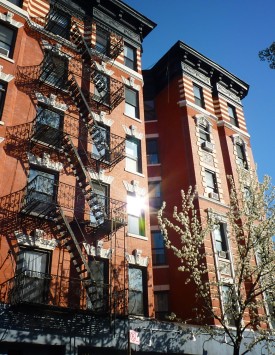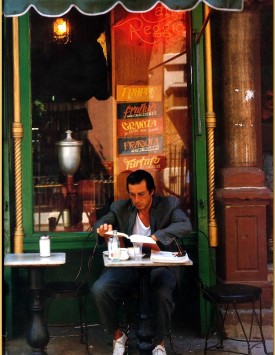The West Village is the western (and original) portion of the Greenwich Village neighborhood in the New York City borough of Manhattan. The area is bounded by the Hudson River on the west and either Sixth Avenue or Seventh Avenue (depending on the different opinions) on the east, extending from 14th Street down to Houston Street. The Far West Village extends from the Hudson River to Hudson Street.
Known as “Little Bohemia” starting in 1916, West Village is in some ways the center of the bohemian lifestyle on the West Side, with classic artist’s lofts in the form of the Westbeth Artists Community and Julian Schnabel’s Palazzo Chupi. It is also the site of sleek new residential towers designed by American architect Richard Meier facing the Hudson River at 173/176 Perry Street.

The High Line connects the historic district to the art galleries in Chelsea and points north. The elevated train tracks running parallel to Tenth Avenue have been converted to an open greenway. The tracks once served the businesses in the area, but have been long abandoned and converted into a popular public park.
The neighborhood is distinguished by streets that are “off the grid” — set at an angle to the other streets in Manhattan — sometimes confusing both tourists and city residents alike. These roads were laid out in an 18th-century grid plan, approximately parallel or perpendicular to the Hudson, long before the Commissioners’ Plan of 1811 which created the main street grid plan for later parts of the city.

The Meatpacking District at the north end of this neighborhood, also known as the “Gansevoort Historic District” is filled with trendy boutiques, nightclubs, restaurants and hotels – including the Standard Hotel, Beaumarchais and Spice Market.
Greenwich Village, often referred to by locals as simply “the Village”, is a largely residential neighborhood on the west side of Lower Manhattan in New York City, in the U.S. state of New York. A large majority of the district is home to upper-middle-class families. Greenwich Village, however, was known in the late 19th to mid-20th centuries as an artists’ haven, the bohemian capital, and the East Coast birthplace of the Beat movement. What provided the initial attractive character of the community eventually contributed to its gentrification and commercialization. The name of the village was Anglicized from the Dutch name Groenwijck, meaning “Pine District”, into Greenwich, a borough of London.
The neighborhood is bordered by Broadway to the east, the Hudson River to the west, Houston Street to the south, and 14th Street to the north, and roughly centered around Washington Square and New York University.

The Village hosted the first racially integrated nightclub in the United States when the nightclub Café Society was opened in 1938 at 1 Sheridan Square by Barney Josephson. Café Society showcased African American talent and was intended to be an American version of the political cabarets Josephson had seen in Europe before World War II. The Village had and continues to have a cutting-edge cabaret and music scene. The Village Gate, the Village Vanguard and The Blue Note (since 1981), hosted some of the biggest names in jazz on a regular basis. The historic Washington Square Park is the center and heart of the neighborhood, but the Village has several other, smaller parks: Father Fagan, Minetta Triangle, Petrosino Square, Little Red Square, and Time Landscape. Apartment prices remain high despite economic fluctuations. Some say the West Village is downtown’s most desirable residential area, and its future is sure to be reinforced by the emergence of many architectural projects along the High Line just to the north in Chelsea.


